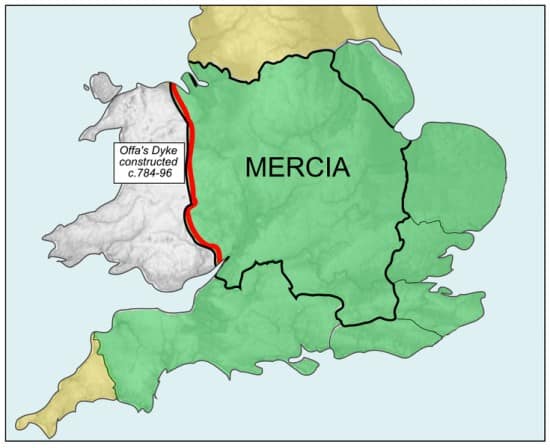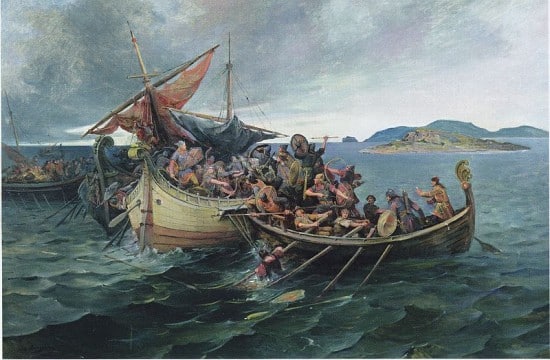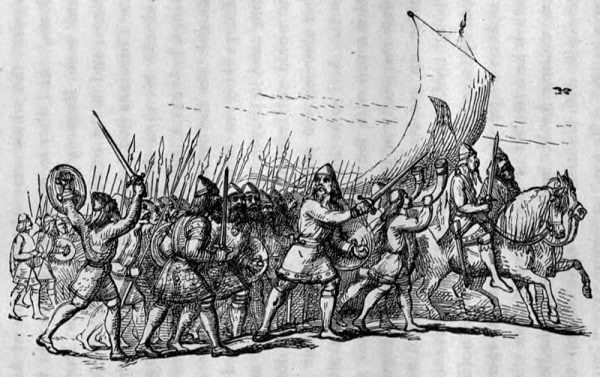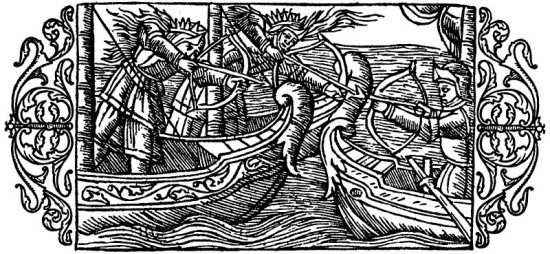It is oversimplified to say that the ViKing Age started with vikings saccing the monastery at the island of Lindisfarne in AD 793. However, that event and year has in many ways come to symbolize the start of the ViKing Age.
That was actually not the first visit by the people the Anglo-Saxons called Danes to the British isles. As I will dive into here, they had in fact killed a man named Beaduheard, one of the King of Wessex’ men four years earlier, in AD 789.
In later years there has been somewhat of a movement to cast the vikings as tradesmen and explorers. I feel that is somewhat misplaced, and maybe based on a desire to make them more “likable”. To really understand them, you need to take into account the warrior culture they came from, and how that clashed with Christianity which was spreading in Europe.
These early ventures across the North Sea by the vikings to the British isles were the start of almost three hundred years of viking exploration, settlement and battles. They would reach all the way to Vinland (North America) in the west, to Constantinople in the south and Middle East and into what is today Russia and Ukraine in the East.
England in the late 8th century
After the Romans left Britain in the 5th century, the land went into several hundred years of relatively hard times. With no single ruler, and an influx of people from mainland Europe, there were several warring factions. Then in the west and north there were the Celts who were different from the Roman-Britons and the Jutes, Saxons and Angles who all shared what is now known as Wales, England, Scotland and Ireland.
After several centuries of these different groups fighting, and consolidating, they seem to become more alike as well. Besides the Celts, who kept a distinct culture, the Anglo-Saxons who didn’t necessarily see themselves as the same early on, were largely one group, divided across seven kingdoms.

Towards the end of the 8th century, the most powerful kingdom was Mercia, situated in the middle of England. Ruled by King Offa, they had beaten the armies of several of the other kingdoms and he declared himself the King of England.
In AD 789, King Beorhtric of Wessex, married the daughter of King Offa. This furthered the influence of King Offa and brought Wessex firmly under Mercia.
The Vikings Arrive on the Isle of Portland
Having experienced decades of relative peace towards the end of the 8th century, the Anglo-Saxon kingdoms were not overly militarized. They were christian, ruled by a handful of kings across seven kingdoms, and most people were peasants.

In other words, they were a soft target, ill-prepared for what was to come.
This became abundantly clear for the people living on the small island of Portland, just off the coast of southern England. It is a tied island, meaning it’s partially connected to the mainland, by a narrow extension of the beach. It is not that big, only about four by two miles. However, it is lush and green and it has been inhabited for thousands of years, since the stone age.
This island was largely populated by people living off the land and the plentiful fishing out in the English channel. The climate in this part of England is quite mild and farmers would likely have been thriving, with long warm summers and short mild winters.
Barbarians at the Gate
To really understand the clash of cultures that happened in Portland that summer, you need to appreciate who the vikings that came were. Although called “Danes” by the Anglo-Saxons, they are recorded as having said they came from Hordaland. This is the western part of Norway, with harsh winters, craggy mountains and smaller areas suitable for farming. Life was hard.
Furthermore, their culture was one of warriors, clans and raiding. A man’s first responsibility was to his family and possibly chief, or jarl. Already as children, boys would wrestle, learn to throw a spear, and fight with a sword or an ax. For most, the ultimate goal for a trip like this was riches and slaves, and at the very least, an honorable death in battle.
The vikings came in only three boats. This is mentioned in the Anglo-Saxon Chronicle for AD 789, but it makes no mention about the size of them. They might have been so-called longships, the largest, and fastest of the traditional viking ships. On the other hand, they could also have been knarr’s, which were wider and a bit slower. However, even if the boats were of only average size, each one might have held a dozen to twenty men. When these forty to sixty ferocious warriors descended on the island, all stereotypes of viKing behavior likely held true.
The mostly defenseless islanders would have been victims of murder, rape, plunder and pillaging.
It is unclear just how long the vikings were on Portland, and how far onto the mainland they might have ventured. However, with the easy pickings they found on Portland, they might have been busy making the most of it.
The Raid on Portland in Ancient Sources

Found in the Anglo-Saxon Chronicle for AD 789, you can read:
Here Beorhtric took King Offa’s daughter Eadburh. And in his days came first 3 ships from Hordaland:[b] and then the reeve rode there and wanted to compel them to go to the king’s town because he did not know who they were; and then they killed him. These were the first ships of the Danish men which sought out the land of the English race.
Comment
I want to point out that although called Danes, this was evidently a name the Anglo-Saxons used for the Norsemen who apparently had showed up now and then. Otherwise, why would they have a name for them? It would also make sense if the first to come were vikings from Denmark, as Denmark is much closer to the southern coast of England than western Norway is.
Another version ot the Chronicle, known as the Chronicon Æthelweardi, a Latin translation of a lost version of the Anglo-Saxon Chronicle, goes into more detail:
Suddenly a not very large fleet of the Danes arrived, speedy vessels to the number of three; that was their first arrival. At the report the king’s reeve, who was then in the town called Dorchester, leapt on his horse, sped to the harbour with a few men (for he thought they were merchants rather than marauders) and admonishing them in an authoritiative manner, gave orders that they should be driven to the royal town. And he and his companions were killed by them on the spot. And the name of the reeve was Beaduheard.
It is worth noting that Æthelweard was writing nearly 200 years after the event. Believed to be sometime between AD 975 and AD 983. His account is apparently the first to name Beaduheard; however, as his work was a Latin translation of a (now lost) Anglo-Saxon original, there is nothing to suggest that the name is incorrect. I would however venture a guess that he wasn’t baptized Beaduheard as the name seems to have been gained as an adult.
Reports of Marauders Reach Beaduheard
The largest town close to Portland was Dorchester, which had been held by the Romans a few centuries earlier. In 789 however, it was a market town and center of commerce for the surrounding areas of what is today Dorset.
In Dorchester, the local reeve (like a magistrate, official of the crown), received news of some kind of trouble on the isle of Portland. The reeve was named Beaduheard, which means something like Battle-hard, or Battle hardened. Little else is known of the reeve. However, based on the name alone, and his position it seems a safe assumption he had some experience from battle.
Dorchester is only about fourteen miles from Portland. Upon receiving the news, Beaduheard summoned a few men to follow him and they rode out to investigate. With no real experience with marauding foreigners, Beaduheard likely believed the men to be merchants from across the channel. This part of England is only a couple of days sail from Portugal and Spain, and mere hours from France.
The First Anglo-Saxon Battle with Vikings
It is a stretch to call what happened next a battle. There really weren’t that many men involved, and it was likely quite one-sided. Believing he would give the foreigners a harsh talking to, and then round them up and bring them to Dorchester. The good Beaduheard was likely surprised by what met him.

Imagine riding along with a handful of men, a feared and respected man of the king, and then meeting the vikings on Portland. Hardened men, some with beards, others with long and unruly hair, watching him and his men suspiciously. Tattooed, speaKing in a foreign language, and increasingly hostile.
The vikings killed Beaduheard and all his men. They probably took all their weapons and any equipment they might have carried and went back to their camp. Sometime after this, and before more officials could be dispatched, the vikings got in their boats and left Portland.
Having plundered the whole island, the men from Hordaland might have been happy with what they had and returned home. Returning home, they would share tales of a green and mild island, with soft, yet rich people. Most likely some of the daughters and wives from Portland would have found a new home in western Norway. Definitely involuntary.
They were the first of many slaves the vikings captured as they would later revisit England and the British isles. Four years later, in AD 793 vikings again landed in England, visiting the monastery on the island of Lindisfarne.

Hey hey! I’m a Nordic scholar from the US. I found your website going down a Google rabbit hole. Just want to say hello! It’s so sweet ya’ll are doing this! It’s a lot of work.
Hey Ashley, thanks a lot, much appreciasted. Great to hear you came across the site, always fun to hear someone with the academic background enjoying the site.